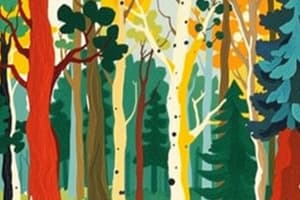Podcast
Questions and Answers
What is an old-growth forest?
What is an old-growth forest?
- Forests primarily used for agricultural purposes
- Forests that are newly planted with young trees
- Virgin and old, second-growth forests with very old trees (correct)
- Forests that have been reclaimed after deforestation
What is a second-growth forest?
What is a second-growth forest?
Stands of trees resulting from secondary ecological succession.
Define a tree plantation.
Define a tree plantation.
A site planted with one or only a few tree species in an even-aged stand.
What is fuelwood?
What is fuelwood?
What is neem known for?
What is neem known for?
What is selective cutting?
What is selective cutting?
What is clear-cutting?
What is clear-cutting?
Define strip-cutting.
Define strip-cutting.
What is a surface fire?
What is a surface fire?
What is a crown fire?
What is a crown fire?
What does the Healthy Forests Restoration Act allow?
What does the Healthy Forests Restoration Act allow?
What is rangeland?
What is rangeland?
Define grassland.
Define grassland.
What is a nature reserve?
What is a nature reserve?
What does wilderness mean?
What does wilderness mean?
Flashcards
Old-growth forest
Old-growth forest
Forests with ancient trees, untouched by human activity, supporting diverse wildlife
Second-growth forest
Second-growth forest
Forests that regenerate naturally after disturbances like fires or logging
Tree plantation
Tree plantation
Areas planted with specific tree species, often harvested for timber and replanted
Selective cutting
Selective cutting
Signup and view all the flashcards
Clear-cutting
Clear-cutting
Signup and view all the flashcards
Strip-cutting
Strip-cutting
Signup and view all the flashcards
Surface fire
Surface fire
Signup and view all the flashcards
Crown fire
Crown fire
Signup and view all the flashcards
Healthy Forests Restoration Act
Healthy Forests Restoration Act
Signup and view all the flashcards
Rangeland
Rangeland
Signup and view all the flashcards
Grassland
Grassland
Signup and view all the flashcards
Nature reserve
Nature reserve
Signup and view all the flashcards
Wilderness
Wilderness
Signup and view all the flashcards
Study Notes
Forest Types and Definitions
- Old-growth forest: Characterized by virgin and ancient trees, often hundreds to thousands of years old, supporting high biodiversity.
- Second-growth forest: Formed through secondary ecological succession, these are stands of trees that regenerate after disturbances.
Tree Management and Harvesting
- Tree plantation: Managed sites planted with one or few tree species, typically harvested by clear-cutting then replanted; often cultivated for rapidly growing species used for fuel, timber, or pulpwood.
- Selective cutting: Involves removing specific mature or diseased trees in uneven-aged forests, promoting younger tree growth and maintaining biodiversity.
- Clear-cutting: A method that entails the complete removal of all trees within a designated area in a single operation.
- Strip-cutting: Modified clear-cutting technique involving narrow corridors cleared along the land's contour, allowing natural regeneration before subsequent strips are cut.
Fire Dynamics in Forests
- Surface fire: A type of forest fire that burns primarily the undergrowth and leaf litter without affecting larger trees.
- Crown fire: A more intense fire that can consume both ground vegetation and the tops of trees, often causing extensive damage.
Legislative Context
- Healthy Forests Restoration Act (2003): Facilitates timber company operations to remove medium and large trees from 71% of National Forest areas in exchange for managing smaller, fire-prone vegetation, bypassing certain environmental reviews.
Land Types and Conservation
- Rangeland: Lands that provide forage for grazing animals and are not subject to intensive management practices.
- Grassland: Biomes characterized by sufficient moderate rainfall to support grass and small plants, but not large trees.
- Nature reserve: Large protected areas established to conserve plant and animal species and their habitats.
- Wilderness: Regions with minimal human presence, preserving natural landscapes and ecosystems.
Studying That Suits You
Use AI to generate personalized quizzes and flashcards to suit your learning preferences.




